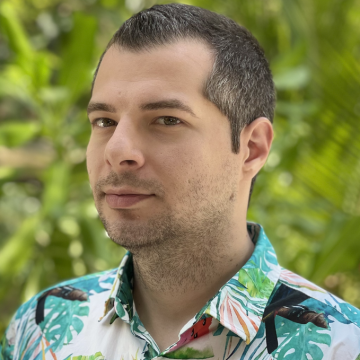
Radu Tudor Ionescu, Ph.D.
University of BucharestAI, ML, computer vision, image processing, medical imaging, text mining, comp. linguistics
Radu Tudor Ionescu is Professor at the University of Bucharest, Romania. He graduated from the Faculty of Mathematics and Computer Science of the University of Bucharest in 2009, and he obtained a Masters of Science diploma in Artificial Intelligence as valedictorian from the same university. He completed his PhD at the University of Bucharest in 2013. He received the 2014 Award for Outstanding Doctoral Research in the field of Computer Science from the Romanian Ad Astra Association. Radu is teaching Artificial Intelligence, Deep Learning, Machine Learning and Computer Vision lectures at the University of Bucharest. His research interests include machine learning, computer vision, image processing, medical imaging, text mining and computational biology. He published over 80 articles at international peer-reviewed conferences (e.g.: CVPR, NeurIPS, ICCV, ACL, EMNLP, NAACL, EACL, WACV) and journals (e.g.: Computational Linguistics, Computer Vision and Image Understanding, Neural Networks, Artificial Intelligence Review, Pattern Recognition Letters), and a research monograph with Springer. Radu received the “Caianiello Best Young Paper Award” at ICIAP 2013 for the paper entitled “Kernels for Visual Words Histograms”. He also received the “Young Researchers in Science and Engineering” Prize organized by prof. Rada Mihalcea for young Romanian researchers in all scientific fields, and the “Danubius Young Scientist Award 2018 for Romania” by the Austrian Federal Ministry of Education, Science and Research and by the Institute for the Danube Region and Central Europe to honor the extraordinary achievements in his scientific activity. Together with other co-authors, he participated at several international competitions. They have ranked on 4th place in the Facial Expression Recognition Challenge of the WREPL Workshop of ICML 2013, 3rd place in the Native Language Identification Shared Task of the BEA-8 Workshop of NAACL 2013, 2nd place in the Arabic Dialect Identification Shared Task of the VarDial Workshop of COLING 2016, 1st place in the Arabic Dialect Identification Shared Task of the VarDial Workshop of EACL 2017, 1st place in the Native Language Identification Shared Task of the BEA-12 Workshop of EMNLP 2017, 1st place in the Arabic Dialect Identification Shared Task of the VarDial Workshop of COLING 2018.
Anomaly detection in video: approaches and challenges
Anomaly detection in video is a challenging computer vision problem, as the classification of an event as normal or abnormal always depends on the context. For instance, driving a truck on the street is considered normal, but, if the truck enters a pedestrian area, the event becomes abnormal. Considering the commonly adopted definition of abnormal events and the reliance on context, it is difficult to obtain a sufficiently representative set of anomalies for all possible contexts, making traditional supervised methods less applicable to abnormal event detection. In this talk, we will present a series of state-of-the-art anomaly detection methods that are trained without direct supervision. The presented methods propose alternative approaches such as designing proxy self-supervised tasks or using pseudo-abnormal examples in an adversarial fashion. Finally, we will discuss open challenges in abnormal event detection.
Keywords: anomaly detection, deep learning, video analysis, convolutional neural networks